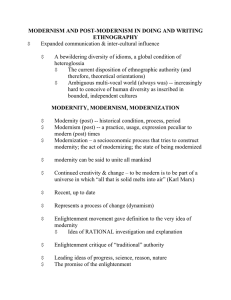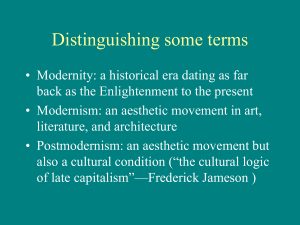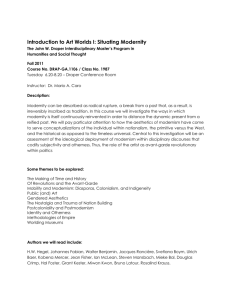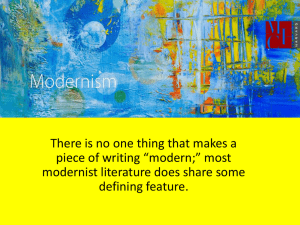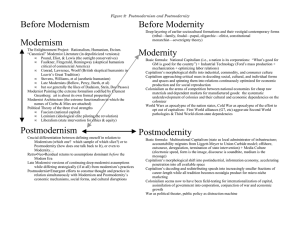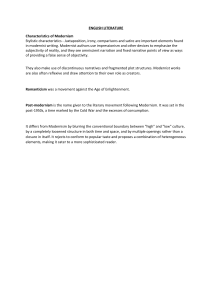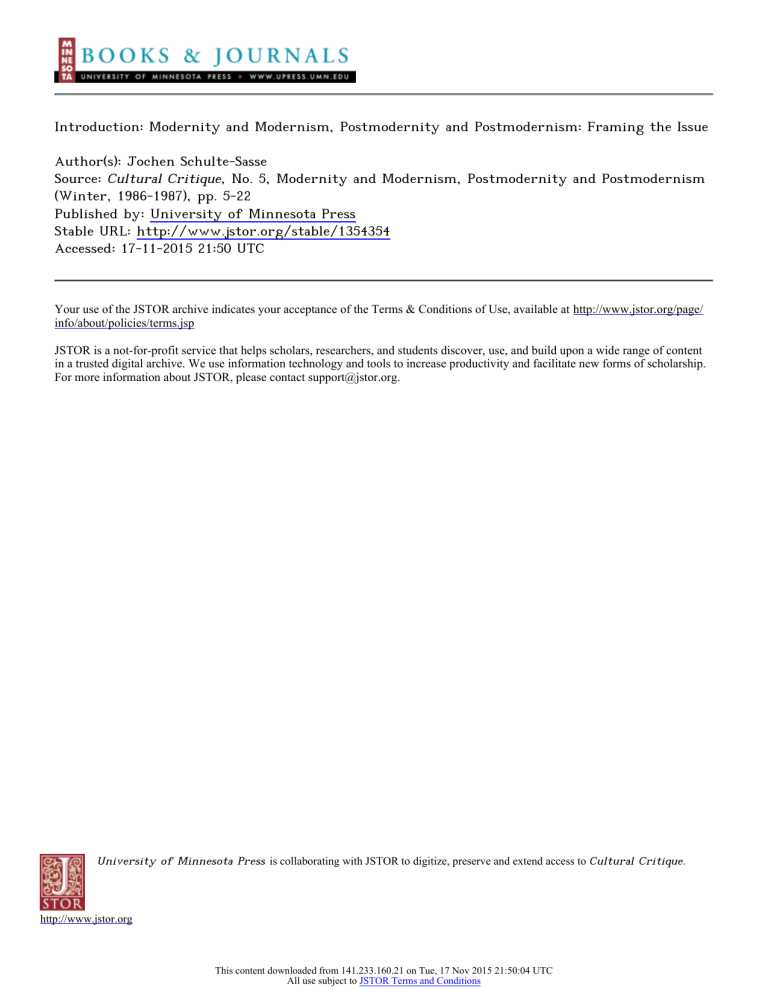
Introduction: Modernity and Modernism, Postmodernity and Postmodernism: Framing the Issue Author(s): Jochen Schulte-Sasse Source: Cultural Critique, No. 5, Modernity and Modernism, Postmodernity and Postmodernism (Winter, 1986-1987), pp. 5-22 Published by: University of Minnesota Press Stable URL: http://www.jstor.org/stable/1354354 Accessed: 17-11-2015 21:50 UTC Your use of the JSTOR archive indicates your acceptance of the Terms & Conditions of Use, available at http://www.jstor.org/page/ info/about/policies/terms.jsp JSTOR is a not-for-profit service that helps scholars, researchers, and students discover, use, and build upon a wide range of content in a trusted digital archive. We use information technology and tools to increase productivity and facilitate new forms of scholarship. For more information about JSTOR, please contact support@jstor.org. University of Minnesota Press is collaborating with JSTOR to digitize, preserve and extend access to Cultural Critique. http://www.jstor.org This content downloaded from 141.233.160.21 on Tue, 17 Nov 2015 21:50:04 UTC All use subject to JSTOR Terms and Conditions Modernity and Modernism, Postmodernity and Postmodernism: Framing the Issue JochenSchulte-Sasse he common usage of the four terms employed in the title of this special issue is confusing at best. I will begin with "modernism," the one term among the four which critics often claim designates a distinct literary movement between the 1850s and the 1950s: in the context of the Reagan administration's arms deal with Iran, former CIA head William Colby held that the ultimate aim of U.S. foreign policy toward Iran is that country's "return to modernism and civilized international relations." Los Angeles Times columnist William Pfaff criticized Colby together with Reagan's special envoy to Iran, Robert McFarlane, and then-national security adviser John Poindexter for their political agenda regarding modernism: "They do not acknowledge that the Iranian revolution is driven by the rejection of exactly that modernism - and that it is a profound movement, encompassing elites as well as the masses." Are we to think that the political agenda of an imperial power like the U.S. is motivated by the desire to convert the population of another country to an -ism? Evidently not. The Webster Dictionary defines "modernism" as the "thought and action characteristic of modern life." That thought and action ob- T 1. MinneapolisStarand Tribune,18 November 1986. 5 This content downloaded from 141.233.160.21 on Tue, 17 Nov 2015 21:50:04 UTC All use subject to JSTOR Terms and Conditions 6 JochenSchulte-Sasse viously has a material base, vaguely and indeterminately referred to by the Webster as "modern life." As the essays published in this issue make abundantly clear, we need a term that refers solely to the social dimension of modern societies and a separate one that refers to the cultural movements within these societies. Modernity, then, would mean a form of society or social organization characterized by industrialization, so-called high capitalism, etc. Its beginnings can be found in the eighteenth century and its culmination in the nineteenth and early twentieth centuries. The culturalprecipitates of this socio-historical period should be called modernism. If there is any validity to the claim that the mode of materialreproduction of a given society corresponds to the mode of its culturalreproduction, and vice versa, then the term "modernism" should include products of both so-called high culture and mass culture. In an analogous manner, the term postmoderity should designate a mode of materialreproduction of society that has succeeded the period of modernity; whereas postmodernism should refer solely to the mode of cultural reproduction of that sociohistorical period. The inflationary and often contradictory use of the term postmodernism does not have to concern us as long as it is understood that postmodernity and postmodernism refer to qualitative changes in society and their cultural manifestations. At first glance, my attempt to arrive at a common understanding of these terms seems to be contradicted by at least one of the following essays.Jean-Francois Lyotard holds that" 'postmodern' is probably a very bad term, because it conveys the idea of a historical 'periodization.' 'Periodizing,' however, is still a'classic' or'modern' idea. 'Postmodern' simply indicates a mood, or better, a state of mind." Accordingly, he claims that"Freud, Duchamp, Bohr, Gertrude Stein, but also Rabelais and Sterne, are postmodern in that they emphasize paradoxes. Still, there is a difference between a social system in which this mood is an arbitraryone, seemingly unrelated to prevalent mentalities of that culture, or is visible in over-sensitive reactions to emerging but still sub-dominant features of that society and a different social system in which that very mood is part of the dominant features of that society. However these terms are employed, they should be used as analytical categories apprehending features of and differences between societies and cultures. Such a usage would prevent a lot of confusion if commonly accepted. How, for example, is one to understand the following This content downloaded from 141.233.160.21 on Tue, 17 Nov 2015 21:50:04 UTC All use subject to JSTOR Terms and Conditions Introduction 7 statement in one of the more substantial recent publications on postmodernity and postmodernism: "Postmodernism [die Postmodere] should be questioned about its capacity to break away from the dialectic of Enlightenment and of modernity and to inspire a new emancipatory practice."2What sense could such a statement possibly make, unless the author wants to claim that cultural movements originate in the free will of subjects who act as independent historical agents and that - if postmodernism cannot deliver what this author expects it to deliver - it can and should be discarded. Compared to such a statement, William Colby's use of "modernism" looks genuinely materialistic. II One question which nearly every essay in this volume pursues or at least touches upon is the status of art - the institutional mode of its existence - in modernity and postmodernity. If Linda Hutcheon is right in stating that "both its supporters and its detractors seem to want to call 'postmodernism' in art today... [that] art [which is] marked primarily by an internalized investigation of the nature, the limits, and the possibilities of the language or discourse of art," then one could call the essays included in this issue postmodern as well. There is reason to believe that modernity led to an organizational differentiation of modern societies in which the aesthetic took over a functionally differentiated role without artists reflecting upon the impact this functional differentiation had on art. The historical avant-garde was, according to Peter Burger,3 the first movement to comprehend fully the separateness of art in modernity; it responded to that discovery with its failed attempt to lead art back into life. Postmodernism, one could argue, is that movement in the history of art that does not attempt to overcome the separateness of art and life anymore; it accepts the fact that the functional differentiation of society is irreversible by allowing this insight to shape art's content. It may very well be that this is the reason why parody has become such a characteristicfeature of postmodern art. Parody,Linda Hutcheon argues in this volume, 2. Gerard Raulet, Gehemmte KrisederEmanzipation(DarmZukunft.Zurgegenwdrtigen stadt and Neuwied: Luchterhand), 9. 3. See Peter Burger, Theoryof the Avant-garde,trans. Michael Shaw (Minneapolis; Univ. of Minnesota Press, 1984). This content downloaded from 141.233.160.21 on Tue, 17 Nov 2015 21:50:04 UTC All use subject to JSTOR Terms and Conditions 8 JochenSchulte-Sasse "allows an artist to speakTO a discourse from WITHIN it, butwithout being totally recuperated by it." Before I go on, I would like to elaborate briefly on the institutionalization of the aesthetic in modernity. In slightly altering the distinction thatJean-Fran5ois Lyotard attempts in his essay "Answering the Question: What is Postmodernism?" one can distinguish between two modes of aesthetic modernism. Both modes presuppose a radical critique of social modernity, particularly of the instrumentalization of reason and language in the course of the civilizing process, of the alienation of people from one another, of the development of increasingly agonistic identities. But while one mode of artistic response intersperses nostalgic, utopian images of a better, reconciled world into its critique of civilization, the other insists upon the necessity of an epistemological critique from within existing discourses and upon the development of a deconstructive rhetorical praxis that can breach those discourses. Among the examples he cites, Lyotard locates "on the side of melancholia, the German Expressionists, and on the side of novatio,Braque and Picasso."4Both modes of modernism are reactive responses to social modernity. Every reactive critique, though, runs the risk of constructing an opposing view that becomes enmeshed in a fundamental epistemological dependence on the very thing it criticizes. In other words, the effect of the restrictivefixation on a particular opposite, which is characteristicof thinking in terms of oppositions, is often limited to a mesmerizing fascination with what already exists, viewing it as the only epistemologically relevant object. One can say that the nostalgic or, as Lyotard calls them, the melancholic representatives of aesthetic modernism had fallen victim to exactly this danger. The question remains whether the mode of deconstructive novatio actually avoids this danger. Can't it too become compensatory when, in the process of social organization, its discourse is differentiated into a separate, aesthetic discourse, which takes on a differential function? Most essays in this volume seem to answer this question in the affirmative. The reason is that the oppositional images and figurations to which critique so often turns may become so dominant in a given culture that their effect reaches beyond the content of individual texts. 4. Jean-Fran;ois Lyotard, ThePostmodernCondition:A Reporton Knowledge,trans. Geoff Bennington and Brian Massumi (Minneapolis: Univ. of Minnesota Press, 1984), 80. This content downloaded from 141.233.160.21 on Tue, 17 Nov 2015 21:50:04 UTC All use subject to JSTOR Terms and Conditions Introduction 9 They begin to determine the hierarchy of discourses in that culture - a hierarchy which is a semiotic fact as well and which channels both the process of signification and of human interaction. Thus a rational, logical, and instrumental discourse may, on the level of societal differentiation, be opposed by an emotional, alogical discourse which is as "public," as institutionalized as the instrumental one. The judicial discourse, for example, belongs to the former group; the discourse of music or love to the latter. In such a differentiated world of discourses a socially critical, oppositional discourse may assume religious or compensatory functions. There are indications that this is the function the aesthetic discourse in the broadest sense, which includes the mass mediawith its strategies of narrativizing events, generally fulfills in modern societies. Here seems to lie the reason why, on the one hand, modern aesthetic theory is influenced by socially critical oppositions like identity and dissolution, rationality and irrationality, alienation and a classless society, the worldly and other-worldly, myth and logos, primary and secondary processes; whereas, on the other hand, the differential function of the aesthetic discourse in modern societies vis-a-vis other subsystems of modernity has institutionally always already achieved a defusion of those oppositional figurations, a transformation of their critical content into nostalgic, utopian images which reconcile the opposition in an imaginary mode. To quote the eighteenth-century philosopher William Duff, who plays a major role in my own contribution to this volume, the emergence of a need to compensate "the diversity, dissipation, and excessive refinements ... in modern ages" in the imaginary realm of art was a newly emerging historical phenomenon that corresponded to a new structural organization of society - in the terms of the German sociologist Niklas Luhmann, to a functionally differentiated society. The importance of the emergence of an autonomous aesthetic sphere is dialectically dependent upon the degree of differentiation our consciousness has undergone. The aesthetic, and here especially the narrativegenres, has been institutionalizedas that medium which expresses both on the level of content and on that of reception a desire to dissolve or decenter identity in order to domesticate this desire in the delimited realm of art. That is why Lyotard's discussion of Romanticism (see below: "Romanticism was relegated, still kicking, to the culture of nostalgia")has to be expanded into a discussion of the institutionalization This content downloaded from 141.233.160.21 on Tue, 17 Nov 2015 21:50:04 UTC All use subject to JSTOR Terms and Conditions 10 JochenSchulte-Sasse of the aesthetic as a compensatory medium. Aesthetic pleasure presupposes, especially in the form of decentering identifications, a loosening of subject boundaries, while at the same time delimiting such an activity to special moments (aesthetic pleasure) centered around special objects (art). Art in modernity is an expression of an ambivalent vacillation between desires to decenter or dissolve our selves, and the domesticating and delimiting pleasures of intellectual mastery. In modern societies, the experience of our life-world is fragmented because of its reduction to subsystems that are in many cases quite incompatible with or at least independent from one another. The human desire for a general view or meaning of life finds itself compelled to form myths which, for the demythologizing mind, turn out to be the peremptory results of the differentiation of society and the collective psyche. In other words, the human desire for a general, totalizing understanding of our life-world finds itself displaced into an imaginary realm which relates to the actual goings-on in society in a purely compensatory fashion. The functional integration of compensatory imaginary experiences into modernity is, of course, a highly contradictory one. The aesthetic might be able to compensate, but it cannot synthesize, as so many theoreticians of modernity have claimed, the different strands of subjectivity into a symbolic form that would allow an at least imaginary conquest and "whole" understanding of our subjectivity. The compensatory function of the imaginary undercuts its possible synthesizing function as a symbolic form since both functions force the aesthetic into different directions. If I understand Lyotard's argument in "Answering the Question: What Is Postmodernism?" at all correctly, then this is exactly the point at which Lyotard feels compelled to revive Kant's notion of the sublime. In Kant's thinking, the sublime is that which, because of its vastness, is unpresentable, just as the latent foundation of our subjectivity is unpresentable because it is always already determined by the differentiation of society. To quote Lyotard:"modern aesthetics is an aesthetic of the sublime, though a nostalgic one. It allows the unpresentable to be put forward only as the missing contents; but the form, because of its recognizable consistency, continues to offer to the reader or viewer matter for solace and pleasure .... The postmodern would be that which, in the modern, puts forward the unpresentable in presentation itself; that which denies itself the solace This content downloaded from 141.233.160.21 on Tue, 17 Nov 2015 21:50:04 UTC All use subject to JSTOR Terms and Conditions Introduction 11 of good forms, the consensus of a taste which would make it possible to share collectively the nostalgia for the unattainable."5 If, as Lyotard argues in this issue, capitalism has become "a figure that is not 'economic' and 'sociological' but metaphysical" - in the sense that it has appropriated the infinite desire of the will to know, to determine, and has turned it into a structureof indefinite displacement of fulfillment - then art, in contrast, expresses our desire for presence, for a standstill that arrests time and achieves a timeless moment of fulfillment, of experiencing an imaginary and secular uniomystica. To make matters even more complicated, this desire for the mythic, for dissolution, for the archaic, in Freud's terms, for the oceanic exists or remains, of course, not outside the temporal structure of capitalism; the imaginary moment of rest is always already inside that structure and overdetermined by it. Its status as the other of the infinite displacement of fulfillment in capitalism is not only dependent upon the existence of that temporal chain, it is part of that chain. For example, Romanticism, as all art in modernity, is anticapitalistic withinits being capitalistic; it is an (imaginary) moment of rest within an infinite chain of displacements. One could even go so far as to say that the constant displacement of desire in capitalism has been turned into a desire to experience the infinity of displacing desire, a desire of the second order; aesthetic pleasure is an essential part of this second-order desire, its aesthetic nature establishes its repetitious character.The infinity of the will invests and cathects different institutions of modern societies with different strands of its own desire: it invests and cathects the aesthetic with a different mode of desire than the economic. When I develop thoughts like these to friends with whom I share the memory of a political struggle whose intellectual underpinnings were determined by assumptions of what a "right" or "wrong" ideological identity was all about, that is, by an agonistic concept of history and truth, I usually hear that such theorizing leads to a blindness vis-a-vis alienation in modern societies, and that the aesthetic remains the only locale in modernity allowing the dream of an unalienated existence to survive. But a figure of thought that centers around alienation andjuxtaposes alienated social experience with unalienated aesthetic experience, supposedly the only mode of unalienatedexperience in modernity, falls prey to the organizational logic of capitalism without ever comprehending the driving force behind that logic. 5. Lyotard, 81. This content downloaded from 141.233.160.21 on Tue, 17 Nov 2015 21:50:04 UTC All use subject to JSTOR Terms and Conditions 12 JochenSchulte-Sasse It is a genuinely modernistic stance in the sense that it presupposes the possibility of an epistemological position outside the system from which an artistic critique or attack on the system can be launched. Several of the essays collected in this volume bear witness to the omnipresence of that stance in modernism. Russell Berman, for example, investigates the tendency of aesthetic and political vanguards to "present themselves as carriers of ideas, values, or theory" that are superior to the "subaltern, venally materialist masses." In the estimation of modernist vanguards around the turn of the century, "most of the denigrated masses cannot participate, while the vangardist stages an exemplary life-style in which one value-sphere (aesthetic or political) displaces a plurality of competing interests," thereby generating "a motive for bureaucratic administration." (From a psychological perspective, this shows again that modernism is still centered around the notion of strong super-egos.) In this context, Berman underlines Henry Adams's "insistence on sensuous immediacy, aesthetics, and experiential irrationality hostile to the logic of conceptual thought." The epistemological and elitist stance of modernist culture leads to its "adversarial character": "Although the subsequent partisan allegiances led to extraordinarilydivergent commitment . . , the aesthetic critique of bourgeois society was generally intended as part of a radical social transformation." But the cultural and political program of modernism was doomed to fail precisely because this aestheticadverseness (which it is, as Berman shows, even in the case of Max Weber and Henry Adams) was always already institutionally defused. Or, to put the same process into a different perspective, the movement realizes its goals only in the imaginary. Modernists' epistemological and elitist stance turned their critique into a ratherabstractendeavor. This abstractnature of their opposition might very well be the source of the failure of both aesthetic and political vanguards in modern societies. It is interesting to read a statement on Thomas Mann'sDr.Faustusin Scherpe'sessay in this context: according to Scherpe, Thomas Mann's "reflections [in this novel] about the diminished viability of a parodying and ironic narrativestance, which were the trademarkof Mann's art [before this novel], are an expression of the narrator'sprecarious situation; irony, which was supposed to be the means of saving humanistic values in the global epic, might just fail." It had to fail precisely because Mann's modernist irony presupposes a stance outside the object of irony whereas postmodern parody, This content downloaded from 141.233.160.21 on Tue, 17 Nov 2015 21:50:04 UTC All use subject to JSTOR Terms and Conditions Introduction 13 as Linda Hutcheon develops it in this issue, does not claim to speak from a position outside the parodied. Comprehending the claim inherent in the epistemological selfpositioning of modernism, that is, to be capable of launching a critique from outside the system, bears greatly on any assessment of the potential of aesthetic experience as unalienated experience in modernity. Alienation never simply exists objectively. First and foremost, it is a historico-philosophical figure of thought. Second, it refers both to a material and semiotic organization of modern societies. As a historicophilosophical figure, it tends to project a desire that is genuinely dependent on current forms of societal organization into a past or a future. This is why historico-philosophical projections are of a fundamentally aesthetic nature; their aesthetic nature undercuts their claim of being political. As a term that refers to a material and semiotic organization of modern societies, alienation designates an institutional aspect of the capitalistic system that exists in dialectical dependence upon its opposite, institutionalized modes of overcoming alienation. It probably does not make any sense to talk about alienation in reference to something outside the capitalistic system. An epistemological position outside that system, from which the concept of alienation would make sense as a historico-philosophical category that cognitively could open up the system does not exist. As a figure of thought, alienation is a modernist category. It refers to a typically modernist reaction to society; the modernist who stylizes him- or herself as alienated otherness has to establish his or her self as a homogeneous, fortified identity. Such identity exists/existed on the level of mass culture as much as on that of high culture. To be sure, capitalist societies contain what leftist critics refer to as alienation as an essential element of its mode of social organization. But those aspects of the system which the term "alienation" tries to conceptualize cannot be isolated and criticized in the way these critics propose, since they are not fundamental enough to elevate "alienation" to the rank of a principal or central category within the analysis of capitalism. Ironically,the modernist Habermas seems to see these consequences quite clearly. Accepting the mode of social organization established in modernity as a historical achievement that should not be abandoned, he acknowledges the consequences of such a stance and assents to the necessity of institutionalizing modes of unalienated experiences caThis content downloaded from 141.233.160.21 on Tue, 17 Nov 2015 21:50:04 UTC All use subject to JSTOR Terms and Conditions 14 JochenSchulte-Sasse pable of compensating for alienation experienced in other spheres. The issue at stake in debates originating in Habermas's attacks on postmodernism is therefore the legitimacy of the functional differentiation of modernity. In this sense, it is definitely correct to claim, as David Wellbery has done in a recent article, that the "debate on postmodernism is a conflict waged on the terrain of the symbolic: a conflict alsofor symbolic orders in the sense that the parties involved want their own symbolic system to be recognized, to predominate in To caution against a shaping the culture's self-understanding.... 'return to myth' is necessarily to posit a normative itinerary, an Odyssey of modernity, if you will, that steers clear of the Circean sphere and brings thought back to its homeland."6 Habermas refers the Other of reason to the aesthetic realm, thus delimiting it; or to be more precise, when he charges postmodernism with hypostatizing "the aesthetic, as the gate to the dionysian, as the Other of reason,"7he presupposes that the dionysian, once integrated into the functional differentiation of modernity and delimited within its own subsystem, is not the Other of reason, but its complement. The relation of the aesthetic to the utopian ideal of a historical philosophy, which was so constitutive for the perception of the aesthetic in early modernity and which led to an aestheticization of history around 1800, has been abandoned by Habermas in favor of an institutional delimitation of the dionysian; the latter is restricted to the preserves of a separate institution. Habermas simply draws the necessary conclusion from the fact that the notion of a differentiated society is incompatible with the notion of a future sublation of differentiated social interaction in modern societies in a state of secular reconciliation. In other words, Habermas acknowledges the fact that rationality and art cannot be reconciled on the level of their institutionally differentiated existence; they rather become reconciled on the higher level of societal organization which represents a rationality of the second order. III The thoughts so far elaborated upon stake out a theoretical and his6. David Wellbery in "Nietzsche/Art/Postmodernism: A Reply toJiirgen Habermas," forthcoming in StanfordItalian Review. 7. Jiirgen Habermas, Derphilosophische DiskursderModere (Frankfurt/Main:Suhrkamp, 1985), 120. This content downloaded from 141.233.160.21 on Tue, 17 Nov 2015 21:50:04 UTC All use subject to JSTOR Terms and Conditions Introduction 15 torical framework that, to different degrees, is shared by every essay in this issue. There are, of course, a number of arguments developed in the issue that are incompatible with each other. Our purpose is definitely not to cover such discrepancies up - on the contrary. In the following I will point to some of the differences both between the essays themselves and between the positions found in individual essays and in those of some of the editors of CulturalCritique. The essay that provoked the most heated response is Neil Lazarus's on white South African literature. It was the feeling of at least one reader that Adorno's aesthetics of resistence might serve here as a figure of thought with which the author, a white South African intellectual teaching in the U.S., not simply comprehends but possibly heroicizes the position in which his social group finds itself. No matter how well intentioned and politically and morally superior the political standpoint of white writers described by Lazarus might be, the question must be addressed whether - in a situation like the current South African one - a stance that takes Adorno's socio-aesthetic philosophy as a model, that is, a purely modernist resistence to society, suffices? Does the totalized modern society Adorno theorized upon when facing the three-headed bloc of Nazi Germany, the Soviet Union, and capitalist America with its culture industry really have an equivalent in the current South African system or is there in the case of South Africa always already the non-totalizable duplicity of two sides, visible in the colors of black and white? Isn't this a society that cannot be "totalized" and that therefore makes a more radical choice than modernist resistance unavoidable? Is it under such circumstances really legitimate to speak of the "poverty of cultural options open" to white South African intellectuals, as Lazarus does? The most pressing question raised by Lazarus is whether the duplicity characteristicof South African society, which can be considered tantamount to another duplicity of global proportions (that between the "first"and the "third"worlds), can ever be eliminated as a result of historical change, that is, whether postmodern culture can ever become a totalizing global culture. From the standpoint of this question, Lazarus unfolds a critique of Adorno that could be radicalized and turned against the very stance of white South African intellectuals Lazarus tends to defend on the basis ofAdorno: "There is an inability, in Adorno's thinking, to appreciate the cogency of counter-hegemonic activity originating precisely not in the center but at the margins of the world This content downloaded from 141.233.160.21 on Tue, 17 Nov 2015 21:50:04 UTC All use subject to JSTOR Terms and Conditions 16 JochenSchulte-Sasse system." But such hope for historical change remains abstract for Lazarus; in other words, it only leads to an abstract insight into the possibility of change that does not have any concrete consequences. Hope for "progressive"white South Africanwritersis therefore, according to Lazarus, "a massively problematical instance. It involves the acceptanceof a paradox:the futurefor which one works is to be entrusted only to others -. .. in fact, to theOther"- a situation which Lazarus relates to "the discourses of Marxism and anti-colonialism" with their "familiar... injunction to 'commit class suicide.' " What follows from this historical comparison and how valid is it? Does every voice not rooted in material experience, speaking for an Other, fall prey to the same process of centralization and abstraction to which the communist movement fell prey? Does the social situation of white South African intellectuals necessarily lead to an alienation both from the black masses and from their own racial community? Is Adorno's modernist stance really the only possible perspective white South African intellectuals can adopt in their present situation? Lazarus'sessay shares with its object of investigation, that is, Adorno and South African intellectuals adopting his socio-critical stance, the claim of inhabiting an epistemological place outside the system. This becomes most clear when he parallels the epistemological and historical importance of the South African situation with the instance of Auschwitz in Adorno's thinking. Auschwitz functioned "for Adorno as something of an epistemological break within modernity... the mere idea of such a categorical break is enough to suggest the possibility of its dialectical opposite, and to open the way for a view of modernity as heterogeneous and differentially layered, open to the irruptions of what Benjamin called Messianic time." But the political and intellectual option of choosing sides, made possible by such ruptures, again is abstract in nature; it surely cannot solve the problem of agency. Once again one could ask whether proclaiming such an abstract moral option for white South African intellectuals in South Africa's current political situation is motivated by an unconscious desire to heroicize the plight of the intellectual. Any epistemological rupture that is not related to material, concrete tensions and thus is able to induce a process of comprehending the material inscriptions imprinted upon social groups by social praxis falls short of literature's potential to work through such inscriptions. This may be the reason why black South African literature remains outside the problematic of This content downloaded from 141.233.160.21 on Tue, 17 Nov 2015 21:50:04 UTC All use subject to JSTOR Terms and Conditions Introduction 17 a modernist or postmodernist culture and why white intellectuals struggling to find the "right" language for indigenous struggles currently remain outside the mainstream of western culture. Perhaps Lazarus's essay should have been complemented with an essay on black South African literature;such an essay could have reflected upon the necessity of a premodern literature for a dominated and struggling people. But would such an essay belong in the framework of the current issue? Is the reflection on modernity and modernism, postmodernity and postmodernism not always already ethnocentric because it excludes one important dimension of the current global system of capitalism by concentrating on an issue that belongs solely to the "first"world? When Ernst Bloch first spoke of the simultaneity of the unsimultaneous, he thought of different ideological layers within one culture. He tried to theorize discrepancies between ideological blocs in capitalist societies, such as between the romantic anticapitalism of the petit bourgeoisie and the progressivism of white collar workers. Today, the phrase is even more descriptive on a world scale, in relation to the tension betweencultures and/or societies. These are the questions which Rey Chow takesup in her essay with an unsettling insistency. Through a re-reading of Chinese literaryhistory, she shows us how patterns of distinction that western intellectuals impose on the history of Chinese literature reflect - even if formulated from a "postmodern" perspective of diffranceand tolerance - a power relationship between an imperial center and its suppressed margins. She argues that the postmodern acceptance and promotion of "difference" can unfold the same strategies of colonization and lead to the same cultural domination as a more forthright cultural imperialism. She draws the conclusion that "there are always more than one language and one narrative function: between us and the unpresentable are interlocking and unequal narratives,which are further mediated by histories of institutional or political suppression.... What the 'unpresentable' leads us to are therefore also not necessarily the refinement of sensitivity or the reinforcement of tolerance qualities which rather dangerously resemble the 'benign' strategies of certain colonialisms afterthe natives have been conquered - but more truthfully, an alertness to the power politics in all human undertakings."If the cognizing intellectual cannot claim to occupy a position from which he or she can think his or her subject matter unattached, then there are only two possibilities left in regard to the understanding This content downloaded from 141.233.160.21 on Tue, 17 Nov 2015 21:50:04 UTC All use subject to JSTOR Terms and Conditions 18 JochenSchulte-Sasse of otherness, as Rey Chow sees quite clearly when she asks: "Is the cultural historian condemned to ethnocentrism, in that he or she either has to reduce the 'alien' to some culture-bound total vision, or else become utterly incapacitated by the ever-multiplying otherness of even his or her'own' world?" The leftist gesture that for many currently is a guarantor of hope, that is, to "think the margins," and here especially the Third World, might always already be a colonial gesture that incorporates the Other. How Russell Berman's article relates to the questions raised by Lazarus and Chow is obvious from my remarks above.Berman convincingly shows that the epistemological, socio-critical, and artistic presuppositions of modernism had to lead to an abstract moralism that doomed both artistic and political vanguards to failure. Yet Berman seems to draw very few conclusions from these insights. Despite insisting on the abstract nature of modernism's adverseness to modernity, he seems to advocate a similar abstractness when he discusses the fate of modernism in postmodernity. It is surely true that the "termination of the cognitive function of aesthetic culture [in postmodernity] is one consequence of modernist iconoclasm," since that iconoclasm, as I have argued above, was an institutionalized aestheticactivity and served from the beginning a complementary, compensatory function; the paradoxical institutional integration of the asethetic thus had to undermine the remnants of a cognitive function of the aesthetic in modernity. Furthermore, the "experiential models of historical modernism have generated the patterns of mass marketing and consumerist behavior" precisely because there is no reason why an aesthetic that has been functionalized as a compensatory medium within a functionally differentiated society should still be divided into "high" and "low" forms, into elitist and mass entertainment. If this should be the case, can we then really say, as Berman does without qualifications, that the termination of the cognitive function of art "deprives the administrative bureaucracies of one of its erstwhile checks and balances"? When did modernist art ever fulfill such a function? Does Berman not confuse aspects of content, that is, radical gestures of critique on the level of individual works of art, with the institutionalfunctionof art in modernity? A modernist culture that refused to reconsider its basic stance (as an image-critical postmodern culture has done; see as one of the best examples David Lynch's film Blue Velvet)had two options of self-annihilation: one was an authoritarian deterioration, an This content downloaded from 141.233.160.21 on Tue, 17 Nov 2015 21:50:04 UTC All use subject to JSTOR Terms and Conditions Introduction 19 aesthetic Stalinism so to speak, and the other, the dissolution of its radical political ambitions in ornamentalism and consumerism. It chose the latter;it had to choose the latter because of the increased circulation of images in society and the impact that circulation has had and continues to have on the mode of cultural reproduction in postmodernity. Berman, in my opinion, overlooks the role of circulated, capitalized images and the impact they must have on any future act. As George Lipsitz argues in this volume, it "is on the level of commodified mass culture that the most popular, and often the most profound, acts of cultural bricolagetakes place." Lynch's Blue Velvetmay very well anticipate a culture that is both determined by new modes of material and cultural reproduction and that overcomes its affirmative dependence on these modes. As a matter of fact, in regard to culture-political strategies opened up by postmodernity, Berman's and Lipsitz's essays should be read against each other. Berman, for example, speculates that "after administrative capitalism, a deregulation of culture could imply a break-up of culture industry monopolies; a decentralization of cultural production, including the invigoration of regional and local arenas; and broadened popular access to cultural institutions." But he insists that this "program remains problematic to the extent that no substantive agents of popular cultural identity - postmodern corollaries to premodern communities - are available." Using the political underpinnings of Chicano music in East Los Angeles and their strategies of building a historical bloc of oppositional groups as an example, Lipsitz's article gives a wealth of indications that this pessimism might be unfounded. In many ways, Klaus Scherpe's essay implodes any attempt to frame this issue. His comparisons of postmodernism's anarchistic-aestheticist tendencies with similar (pre-fascist)movements in German history is provoking in the best sense; they point to an aspect of the debate that has not been sufficiently dealt with, as evasive rhetorical maneuvers by poststructuralist theoreticians heavily relying on supporters of Nazism can testify. In objecting to some aspects of Scherpe's argument, I by no means want to question the legitimacy and urgency of the questions he raises. But can one really compare the pre-fascist quest for a "life of danger," with which a fascist-modernist consciousness tried to juxtapose itself to the "normality of ordinary bourgeois life," with a deconstructive or postmodernist strategy from within society, from withindiscourse? The pre-fascist authors and intellectual movements This content downloaded from 141.233.160.21 on Tue, 17 Nov 2015 21:50:04 UTC All use subject to JSTOR Terms and Conditions 20 JochenSchulte-Sasse Scherpe describes are all modernist in the sense that they argue (or at least claim to argue) from above or outside a system. Furthermore, does Scherpe not share the epistemological presuppositions of modernism without sufficiently reflecting upon them? Can't Scherpe's critique of Baudrillard only be launched from an epistemologically unquestioned modernist position outside the system, a position Baudrillard obviously thinks is impossible to inhabit? The one aspect of contemporary society every theory of postmodernity and every understanding ofpostmodernism has to consider is that the relationship between the symbolic and the event, between the image and the real has become problematic. As Baudrillard puts it: "All media and the official news service only exist to maintain the illusion of actuality - of the reality of the stakes, of the objectivity of the facts."8In Symbolic ExchangeandDeath,Baudrillard speaks of the hyperof the media.9 reality "Advertising has given rise to talk of festival: without it, the urban environment would be gloomy. But in fact it is only cold animation, a simulacrum of warmth and communication; it beckons nobody, nor can it be taken up again by an autonomous or collective reading, it creates no symbolic network. More than the walls which support it, advertising is itself a wall, a wall of functional signs made to be decoded, whose entire effect is exhausted in the decoding operation."'0 The cultural practice of modernism claimed to be able to resist modernity. Such a claim still presupposes a mode of socialization that is modern, in other words, a mode of identity constitution that allows intellectuals to turn themselves into resistent, fortified entities. If we want to theorize culture as a whole, that is, if we want to grasp dominant modes of cultural reproduction in contemporary society and raise the question how these modes determine art that does not sever its ties with the dominant culture, then any insistence on modernist strategies is merely nostalgic. Thereareno moreagenciesof referencewhichwouldpermitsubjects and objectsto be dialecticallyexchanged,or exchangetheir 8. Jean Baudrillard, Simulations(New York: Semiotext(e), 1983), 71. 9. An English language version of Baudrillard's L'change symboliqueet la mortis forthcoming in Minnesota's THL series. I quote from an earlier version of this translation by Peter Corrigan, referring only to part and chapter of the book. For an elaboration on the term hyperreality see part II, chapter 6. 10. Ibid., part II, chapter 8. This content downloaded from 141.233.160.21 on Tue, 17 Nov 2015 21:50:04 UTC All use subject to JSTOR Terms and Conditions Introduction 21 determinationsarounda stableidentityfollowingdefiniterules: thismarksthe end of the subjectof consciousness.It is temptingto say thatwe are now in the reignof the unconscious.This consequence is logical if the subject of consciousness is the mental is thementalequivaequivalent of the gold standard: theunconscious lentofspeculativemoneyandfloatingcapitals.Individuals today, disinvested as subjects and dispossessed of their object relations, drift about in relationto one anotherin an incessantmode of transferentialfluctuations:with flux, branchings,uncouplings and all societies could very well be detransfer/counter-transfer, scribedin termsof a Deleuze-ianunconscious.... Whyshould the unconscious (even orphaned and schizophrenic)be priviledged?Becausethe unconsciousis the mentalstructurecorresponding to the currentand most radicalphase of the dominant exchange:the structuralrevolutionof value."1 Such statements are analytical regarding the mode of cultural reproduction in postmodernity, which cannot simply be undercut by insisting on the presence of events, of the real. If the new, postmodern mode of cultural reproduction is not simply a manipulative strategy employed by powerful individuals (capitalists or whoever) who stay outside that system of reproduction (which would be a naive assumption), how then do we have to theorize the relationship between media events as pseudo-events and "real" events? Baudrillard, in my opinion, can only be criticized if we accept the challenge of his analysis of postmodern modes of cultural reproduction beforewe criticize his understanding of the relationship between imaginary events in contemporary western societies. Since Scherpe's position remains modernist, he launches his critique, in my opinion, too early. This becomes particularly obvious when he describes Jiinger's modernist aesthetics as "criticism vanished in favor of pure observation." In light of the qualitative changes from modernity to postmodernity, the supposedly unattached position vis-a-vis reality Jiinger shares with Adorno is more essential than the vanishing of criticism inJiinger's writing. If we are always already immersed in the circulation of images, then we cannot criticize society from a secured epistemological position outside those images; we only can undercut that circulation from a position within it. The floating of signs, as analyzed by Baudrillard, is complemented by a structuration on a higher, secondary level, that is, the 11. Ibid., partI, chapter2. This content downloaded from 141.233.160.21 on Tue, 17 Nov 2015 21:50:04 UTC All use subject to JSTOR Terms and Conditions 22 JochenSchulte-Sasse differentiation of social practice into societal subsystems. The determining structuration of society no longer takes place according to principles of value, that is, on the level of money and signs. This seems to be the reason why postmodern art is obsessed with both the parodic undercutting of images and reflections on the institutional status of art in society. It is in this context thatJean-Francois Lyotard's short essay gains its significance. Faced "with the attempt to reduce language to the commercial unit of information, which is supposed to be able to translate all phrases," Lyotard believes "that - in the absence of narratives of legitimation - there is only one possibility left us: to fight for that work ofincommunicability, in other words for the work of the articulation of the possibility of new phrases." In reflecting upon the impact of high technology on postmodern culture, Lyotard approaches the problem from a different perspective than Baudrillard.Yet, the conclusion they draw from their analysis of what one could call a politics of language are similar. In addition, Lyotard's reflections upon the relationship of capital and state bear greatly on an understanding of the status of images in contemporary cultures. New Political Science Summer 1986 No. 15 Literatureand Politics J. Derrida "On the Declaration of Independence" M. Blanchot "Marx'sThree Voices" J. Arac, "Mathiessenand the American Renaissance." D. Sommer, 'Whitman and the LiberalSelf." C. Kay, 'Wollstonecraft's Critique of Adam Smith." T. Norton, "Deleuze and Political Science Fiction." Single issues: $5.50 Individual subscriptions: $20.00 (4 issues) Send check to: New PoliticalScience,Dept. of PoliticalScience Columbia Univ., NY, NY 10027 This content downloaded from 141.233.160.21 on Tue, 17 Nov 2015 21:50:04 UTC All use subject to JSTOR Terms and Conditions

